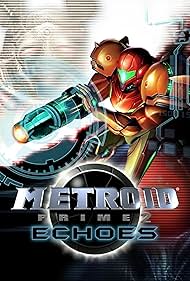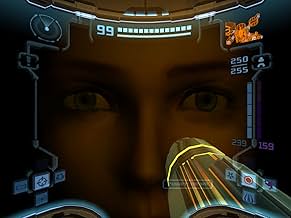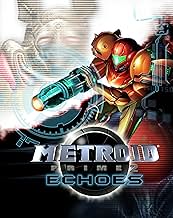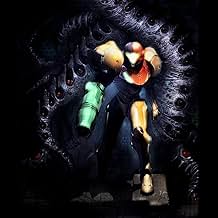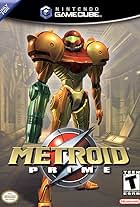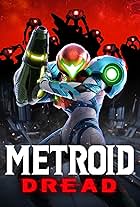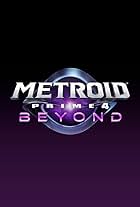Sent to assist a Galactic Federation squadron stranded on the planet Aether, Samus Aran is thrust into an all-but-lost war between the dying Luminoth race and the umbral demons known as the ... Read allSent to assist a Galactic Federation squadron stranded on the planet Aether, Samus Aran is thrust into an all-but-lost war between the dying Luminoth race and the umbral demons known as the Ing, on a world torn between light and darkness.Sent to assist a Galactic Federation squadron stranded on the planet Aether, Samus Aran is thrust into an all-but-lost war between the dying Luminoth race and the umbral demons known as the Ing, on a world torn between light and darkness.
- Nominated for 3 BAFTA Awards
- 7 nominations total
Jennifer Hale
- Samus Aran
- (voice)
- (uncredited)
Vanessa Marshall
- Samus Aran
- (voice)
- (uncredited)
Storyline
Did you know
- TriviaThe large machine parts found in the Sanctuary Temple foreshadow the appearance of a fully assembled Quadraxis, the area boss found in the same area on Dark Aether.
- ConnectionsFeatured in Troldspejlet: Episode #32.5 (2005)
Featured review
(www.plasticpals.com) Hot off the success of Samus Aran's first foray into the 3D realm, Retro Studios went back to work on the inevitable sequel. Samus takes off from Talon IV only to retrieve a distress signal from space marines stationed on planet Aether. The Luminoth are in a life and death struggle with the Ing and it's up to Samus to save them.
Echoing the goals of Mario Sunshine and Billy Hatcher, the goal of the game is to return light to the realms of Luminoth that has been stolen by the Ing and taken to Dark Aether. Dark Aether is another dimension that bears some resemblance to similar dark realms in other games (such as those in Zelda A Link to the Past as well as the Legacy of Kain series). Unfortunately, Samus can only pass between the two dimensions at set portals. An inactive portal can be used to enter the opposing realm by powering it with a beam blast of the right affinity.
Dark Aether, as its name suggests, is an evil realm where visibility is poor. There's a venomous mist that impedes progress by syphoning energy from Samus unless she is protected by small light beacons scattered about the scorched landscape. The Ing have the troublesome ability to dissolve into a sort of oil slick and reappear at will, and some will even disappear into the opposite dimension momentarily to evade detection. Meanwhile, standard creatures that populate Aether can be possessed and transformed by an Ing host, thereby augmenting their natural ferocity and resiliency to weapons.
Once again Samus loses her power suit inventory at the outset when she is ravaged by an Ing horde. While there are plenty of missiles and energy tanks to be found, Echoes does away with the standard beam and visor augmentations found in other Metroid games in favour of entirely new ones. She will find Light and Dark beams, as well as a combination of the two, complementing the new Light and Dark suits (both of which are a nice change of pace from the typical Varia). There's a new multiple lock-on missile launcher. There's a visor for cross-dimensional targeting. And then there's the titular Echoes visor, allowing Samus to see vibrations which are the keys to opening a small assortment of echo locks.
The game is not without its flaws. Making its first leap into 3D is the return of the Space Jump, which works extremely well despite Samus being limited to jumping in a fixed direction. It is acquired late in the game, and is unfortunately limited to only a few key areas. Unlike other Metroid titles, it's used mainly for gaining distance rather than altitude (unless used in conjunction with specially marked walls). It was nice to see it in action but felt like an after thought.
Despite the game's subtitle, the Echoes visor is also largely wasted despite its potential, as it is acquired near the end of the game. Getting around Aether involves a lot of backtracking, exasperated by the existence of two dimensions. Players will be mollified by upgrades they manage to find the second or third time through an area, but the warping ability would've helped had it been available sooner. Dark Aether space pirates annoyingly spawn in the same areas and have the intelligence of their 16-bit predecessors. Some of the enemies in the game, such as the sprightly Rez bits, are annoyingly accurate by comparison.
Naturally, presentation takes a backseat to game play. Entering the portals between dimensions triggers a redundant animation (similar to Mario Sunshine) that would've been much cooler had they copied the twisting distortion effect from Legacy of Kain. There is no voice work in the game, which would have helped the scenes with the space marines and, even if it was gibberish would give voice to the Luminoth (and wouldn't it be cool to finally hear Samus' voice?). The in-game cinematics are beautifully rendered but lack the flair of games such as Metal Gear Solid or Resident Evil 4 and are nowhere near as intricate.
Players will take offence when, during a certain morph ball puzzle, the camera view swings behind a wall, giving the worst possible view of what needs to be done (make the puzzle challenging in and of its own right rather than unfairly hiding the objective!). Speaking of morph ball puzzles, there are quite a few of them in this game and they are all excellently designed.
On the plus side, the game cannot be faulted in the area of graphics, sound, or play control. The many hardships will surely alienate less courageous bounty hunters, but Echoes proves to be an excellent adventure for those worthy of the power suit. Like its prequel, there is an enthralling sense of immersion and atmosphere. Exploring Aether's many secrets, one is overcome by the diversity displayed in each and every environment. The enemies are for the most part species creeping into the decaying Luminoth ruins, with the Ing providing a nice change of pace from the outdated space pirates. Just perfect. The boss battles are challenging, epic in proportion and leave you with a sense of satisfaction when the dust has settled.
In a long line of sequels, Echoes manages to stand out as a unique, Ikaruga-esque addition to the franchise. While I may have focused on the negatives, it is a worthy trek for Metroid fans. The morph ball puzzles are fantastic, some of the best in the series, and you can cut the atmosphere with a knife. The Prime series is all about immersing you into the world, and it does a damn good job of it.
Echoing the goals of Mario Sunshine and Billy Hatcher, the goal of the game is to return light to the realms of Luminoth that has been stolen by the Ing and taken to Dark Aether. Dark Aether is another dimension that bears some resemblance to similar dark realms in other games (such as those in Zelda A Link to the Past as well as the Legacy of Kain series). Unfortunately, Samus can only pass between the two dimensions at set portals. An inactive portal can be used to enter the opposing realm by powering it with a beam blast of the right affinity.
Dark Aether, as its name suggests, is an evil realm where visibility is poor. There's a venomous mist that impedes progress by syphoning energy from Samus unless she is protected by small light beacons scattered about the scorched landscape. The Ing have the troublesome ability to dissolve into a sort of oil slick and reappear at will, and some will even disappear into the opposite dimension momentarily to evade detection. Meanwhile, standard creatures that populate Aether can be possessed and transformed by an Ing host, thereby augmenting their natural ferocity and resiliency to weapons.
Once again Samus loses her power suit inventory at the outset when she is ravaged by an Ing horde. While there are plenty of missiles and energy tanks to be found, Echoes does away with the standard beam and visor augmentations found in other Metroid games in favour of entirely new ones. She will find Light and Dark beams, as well as a combination of the two, complementing the new Light and Dark suits (both of which are a nice change of pace from the typical Varia). There's a new multiple lock-on missile launcher. There's a visor for cross-dimensional targeting. And then there's the titular Echoes visor, allowing Samus to see vibrations which are the keys to opening a small assortment of echo locks.
The game is not without its flaws. Making its first leap into 3D is the return of the Space Jump, which works extremely well despite Samus being limited to jumping in a fixed direction. It is acquired late in the game, and is unfortunately limited to only a few key areas. Unlike other Metroid titles, it's used mainly for gaining distance rather than altitude (unless used in conjunction with specially marked walls). It was nice to see it in action but felt like an after thought.
Despite the game's subtitle, the Echoes visor is also largely wasted despite its potential, as it is acquired near the end of the game. Getting around Aether involves a lot of backtracking, exasperated by the existence of two dimensions. Players will be mollified by upgrades they manage to find the second or third time through an area, but the warping ability would've helped had it been available sooner. Dark Aether space pirates annoyingly spawn in the same areas and have the intelligence of their 16-bit predecessors. Some of the enemies in the game, such as the sprightly Rez bits, are annoyingly accurate by comparison.
Naturally, presentation takes a backseat to game play. Entering the portals between dimensions triggers a redundant animation (similar to Mario Sunshine) that would've been much cooler had they copied the twisting distortion effect from Legacy of Kain. There is no voice work in the game, which would have helped the scenes with the space marines and, even if it was gibberish would give voice to the Luminoth (and wouldn't it be cool to finally hear Samus' voice?). The in-game cinematics are beautifully rendered but lack the flair of games such as Metal Gear Solid or Resident Evil 4 and are nowhere near as intricate.
Players will take offence when, during a certain morph ball puzzle, the camera view swings behind a wall, giving the worst possible view of what needs to be done (make the puzzle challenging in and of its own right rather than unfairly hiding the objective!). Speaking of morph ball puzzles, there are quite a few of them in this game and they are all excellently designed.
On the plus side, the game cannot be faulted in the area of graphics, sound, or play control. The many hardships will surely alienate less courageous bounty hunters, but Echoes proves to be an excellent adventure for those worthy of the power suit. Like its prequel, there is an enthralling sense of immersion and atmosphere. Exploring Aether's many secrets, one is overcome by the diversity displayed in each and every environment. The enemies are for the most part species creeping into the decaying Luminoth ruins, with the Ing providing a nice change of pace from the outdated space pirates. Just perfect. The boss battles are challenging, epic in proportion and leave you with a sense of satisfaction when the dust has settled.
In a long line of sequels, Echoes manages to stand out as a unique, Ikaruga-esque addition to the franchise. While I may have focused on the negatives, it is a worthy trek for Metroid fans. The morph ball puzzles are fantastic, some of the best in the series, and you can cut the atmosphere with a knife. The Prime series is all about immersing you into the world, and it does a damn good job of it.
- robotbling
- Nov 24, 2012
- Permalink
Details
- Release date
- Country of origin
- Official sites
- Language
- Also known as
- Metroid Prime 2: Dark Echoes
- Production companies
- See more company credits at IMDbPro
- Color
Contribute to this page
Suggest an edit or add missing content
